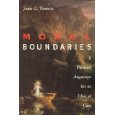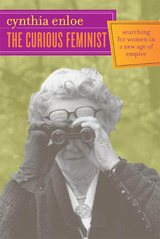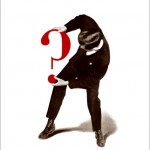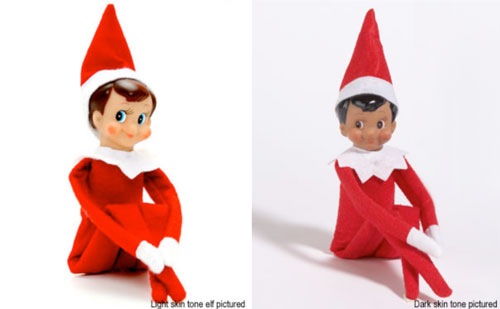It is spring break and I am taking a few days to think through some ideas that keep coming up in my reading, researching and teaching. One idea that I have been experimenting with for some time now is that of troublemaking as a form of care. I can’t quite remember where or when I first started to think that care and troublemaking could (or should) be connected, but this idea seems to be bothering/inspiring/haunting/provoking me lately.
I think one reason that I like connecting care and troublemaking is because much attention (some positive, a lot negative) has been given to the concept of care within feminist ethics. In the context of feminism and feminist ethics, care is popularly understood as being closely tied to nurturing and the re-valuing of women’s work/women’s roles/women’s ways of knowing/women’s practices as mothers and care-givers. This focus produces a narrow framing of the issue: Care = Nurturing = Comfort = Maternal = Women. While this framing does not accurately represent how many feminist ethicists reflect on and use care in their own projects, it can be hard to think of care as a feminist practices outside of the frame of the nurturing mother. I think that linking troublemaking with care could enable us to rethink how we understand care and feminist ethics and how we frame their relationship. At the very least, just thinking about troublemaking (which emphasizes discomfort and uncertainty) as a form of care makes some serious trouble for care and feminist ethics!
 Note: Why, you may ask, am I using the language of frames/framing here? Last week in my grad class on troublemaking, we read the introduction to J Butler’s latest book (May 2009), Frames of War. So the idea of framing is fresh in my mind. I really like Butler’s use of framing as a way to focus (to frame?) her own discussion of grief, war and the livable life. She not only uses the concept of framing as a way to think about how we represent/structure/understand an idea, issue or norm (the frame), but she also argues that we need to spend some time troubling that framing instead of quickly moving to create new frames. At one point in the essay (pages 8-12, to be exact), she traces the meaning of “to be framed” and encourages us to engage in a troubling/calling into question of our frames in order to expose how they always produce an excess/outside that doesn’t fit (drawing upon Trinh T. Minh-ha, she calls this a “framing the frame”). She understands this excess/outside in two different ways: a. (negatively) as a necessary part of the process of framing that functions at the limits and helps to define what one is (A), by what one isn’t (not A) and b. (positively) as the uncontrollable part of the process of framing that always exceeds (breaks with) that framing and enables it to take on new meanings/new contexts. Hmm…does this fit with my discussion of the framing of feminist ethics and care. Yes! But, how? Well, I can’t quite articulate that right now. I will leave it to fester–in my brain and on this blog–for a while…
Note: Why, you may ask, am I using the language of frames/framing here? Last week in my grad class on troublemaking, we read the introduction to J Butler’s latest book (May 2009), Frames of War. So the idea of framing is fresh in my mind. I really like Butler’s use of framing as a way to focus (to frame?) her own discussion of grief, war and the livable life. She not only uses the concept of framing as a way to think about how we represent/structure/understand an idea, issue or norm (the frame), but she also argues that we need to spend some time troubling that framing instead of quickly moving to create new frames. At one point in the essay (pages 8-12, to be exact), she traces the meaning of “to be framed” and encourages us to engage in a troubling/calling into question of our frames in order to expose how they always produce an excess/outside that doesn’t fit (drawing upon Trinh T. Minh-ha, she calls this a “framing the frame”). She understands this excess/outside in two different ways: a. (negatively) as a necessary part of the process of framing that functions at the limits and helps to define what one is (A), by what one isn’t (not A) and b. (positively) as the uncontrollable part of the process of framing that always exceeds (breaks with) that framing and enables it to take on new meanings/new contexts. Hmm…does this fit with my discussion of the framing of feminist ethics and care. Yes! But, how? Well, I can’t quite articulate that right now. I will leave it to fester–in my brain and on this blog–for a while…
 This discussion and reflection on care, troublemaking and feminist ethics is a big project (a book, perhaps?). Right now I want to focus in on some definitions of care offered by those engaged in feminist ethics. Bypassing the definitions offered by Nell Noddings or Carol Gilligan, I want to begin with Joan Tronto’s four part definition of care as it is articulated in chapter 4 of Moral Boundaries: A Political Argument for an Ethic of Care (but also coming out of her work with Berenice Fisher who wrote a fabulous book, No Angel in the Classroom, that I use whenever I teach Feminist Pedagogies).
This discussion and reflection on care, troublemaking and feminist ethics is a big project (a book, perhaps?). Right now I want to focus in on some definitions of care offered by those engaged in feminist ethics. Bypassing the definitions offered by Nell Noddings or Carol Gilligan, I want to begin with Joan Tronto’s four part definition of care as it is articulated in chapter 4 of Moral Boundaries: A Political Argument for an Ethic of Care (but also coming out of her work with Berenice Fisher who wrote a fabulous book, No Angel in the Classroom, that I use whenever I teach Feminist Pedagogies).
Tronto begins her essay by revisiting the definition of care that she created with Berenice Fisher:
On the most general level, we suggest that caring be viewed as a species activity that includes everything that we do to maintain, continue, and repair our ‘world’ so that we can live in it as well as possible. That world includes our bodies, our selves, and our environment, all of which we seek to interweave in a complex, life-sustaining web (103).
In offering this definition, Tronto wants to highlight several features. Caring:
- implies a reaching out beyond the self (relational)
- requires action
- is not limited to human interaction
- is not exclusively dyadic (relationship between 2 people)–not just about mother/child relationship
- is largely defined culturally
- is an ongoing process, not a single act or type of activity
- is a practice and a disposition
- are those practices that have maintaining, continuing, repairing the world as their end
Tronto offers four phases of care that are analytically separate but interconnected in the ongoing process of care:
Phase One: Caring About
Phase one involves the recognition that caring is necessary. It is about paying attention to issues/individuals/communities/nations/regions and identifying their needs.
I am particularly interested in the phase of caring because it resonates with my own linking of care with curiosity and paying attention. I think of caring-as-curiosity as more than just paying attention and recognizing that there are needs to be met through practicing care. Is this phase always (and only) phase one in a larger process of practices? Why is it important to distinguish it analytically from other forms of care? What are the limits or dangers of doing so?
Phase Two: Taking Care of
Phase two involves assuming responsibility for those needs and developing ways to respond to them. This second phase goes beyond identifying a need to the recognition that action is needed and can be taken.
When I think of taking care of something, I often think of solving (or getting rid of) a problem. Tronto doesn’t address the (sometimes) negative tone of this phrase or the potential conflicts between solving a problem (taking care of it) and the need for ongoing care. She does, however, discuss how it is often connected with men and the power/privilege they have in being able to address and solve problems (121).
Phase Three: Care-giving
Phase three involves the actual physical labor that is necessary for taking responsibility and meeting the needs of others. Tronto offers the following as examples: nurse administering medication, repair person fixing a given thing, mother (or father?) talking with her child about the day’s events, a neighbor helping a friend to set her hair (107).
I am struck by her examples here. These activities seem to be overwhelmingly feminine–can a father engage in these caring activities? Or, when a father cares is he engaged in mothering? Tronto does suggest that these are the examples that most quickly spring to our minds–is this true? Is this how we envision care?
Phase Four: Care-receiving
Phase four involves the responses of the person/community/object who receives care. Tronto believes this phase is necessary because focusing on how the object of care responds to that care enables the care giver to assess whether their actions were effective and productive.
Is this another form of paying attention? So, it is not just that we pay attention to the need for care but that we pay attention to our practices of care and the limits and possibilities of that care. Hmm…so maybe paying attention (and caring about how we care) is important for multiple phases of giving care.
After providing her definition and phases of care, Tronto devotes the rest of the essay to exploring how care (as a practice and disposition) is marginalized; is gendered, raced, and classed; and contained as work and as weakness. In terms of containment (and the connections between race/class/gender and containing care), Tronto writes:
…caring about, and taking care of, are duties of the powerful. Care-giving and care-receiving are left to the less powerful (114).
Tronto also discusses the importance of thinking about care as a disposition and a practice. She suggests that envisioning care only as a disposition reduces care/caring work to emotions and the private individual’s emotional investments and intentions. This suggestions troubles me a little as I think about my own interest in promoting troublemaking as a virtue/attitude/approach. It also troubles me as I think about the role of emotions in terms of Sara Ahmed and her discussion of collective feelings. Ahmed is not interested in drawing such a strict division between emotions/feelings and actions. In “Collective Feelings: Or, the Impressions Left by Others,” she argues that “emotions do things” and that “rather than seeing emotions as psychological dispositions, we need to consider how they work, in concrete and particular ways, to mediate the relationships between the psychic and the social, between the individual and the collective” (27). Hmm….
It is helpful for me to work through Tronto’s definition here. In part 2 of this linking care with troublemaking, I want to read chapter 5 of Moral Boundaries–“An Ethic of Care” and think about what this might mean for my exploration of care and for Michel Foucault’s use of care in “The Masked Philosopher” (which I discuss here) and in The Care of the Self: The History of Sexuality, Volume 3.






